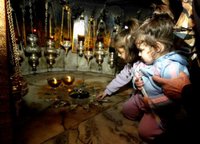 During the reign of the Roman Emperor Caesar Augustus, Jesus Christ was born of the Virgin Mary in Bethlehem, a small town only a few miles from Jerusalem that sits upon a high ridge overlooking the green valley below. She gave birth to him in a cave, wrapped him in swaddling clothes, and laid him in a manger. Simple shepherds from the nearbye fields, hearing of his birth from the angels, visited him in the cave.
During the reign of the Roman Emperor Caesar Augustus, Jesus Christ was born of the Virgin Mary in Bethlehem, a small town only a few miles from Jerusalem that sits upon a high ridge overlooking the green valley below. She gave birth to him in a cave, wrapped him in swaddling clothes, and laid him in a manger. Simple shepherds from the nearbye fields, hearing of his birth from the angels, visited him in the cave.Early Christians venerated the place where Christ was born. Only about 150 years after Jesus’ birth, Justin Martyr, who was born less than fifty miles from Bethlehem, wrote these words: “Should anyone desire proof for the birth of Jesus in Bethlehem let him consider that - in harmony with the story of his birth - a cave is shown in Bethlehem where he was born and a manger in the cave where he lay wrapped in swaddling clothes.” When Constantine the Great ascended to the throne of the Roman Empire, ending the bloody persecutions against the Church and legalizing the Faith, his mother, Helena, a devout Christian, traveled all the way to the Holy Land on a pilgrimage to find the sacred places associated with Jesus’ life. When she reached Bethlehem she visited the cave where Jesus was born.
Emperor Constantine built the Church of the Nativity over the cave. The original church structure remained for about two centuries when it was destroyed during a Samaritan uprising. Emperor Justinian rebuilt the Church of the Nativity, which is still standing today, making it the oldest church in the Holy Land. Inside the cave of the Nativity a 14-point silver star on the marble floor, encompassed by 15 every-burning vigil lamps, marks the place of Christ’s birth.
The Church has survived centuries of conflict. Tradition indicates that when the Persians invaded Bethlehem they decided not to destroy the church after they saw the church’s paintings of the Magi, the Wise Men from the East, who themselves were portrayed as wearing Persian clothing. In April 2002, Israeli Defense Forces invaded Bethlehem, prompting Palestinian gunmen to force their way into the Church of the Nativity, a place of refuge, to escape the Israeli forces pursuing them. A standoff ensued for 38 days until the gunmen, along with several peace activists, agreed to leave.
The Church of the Holy Nativity, still under the protection of the Orthodox Christian Church, is one of the most sacred places in the world, but the Holy Nativity is much more than a historical event in a geographic location. For us, it is a present reality.
(Pictures of Palestinian Christian children in the Church of the Nativity are available on the PalestineToday.org website. The pictures are from December 2003. Photos include: lighting a candle and prayer, another baby in the cave. There is also a photo of Palestinian Christians lighting candles in prayer taken only a few days ago.)
Copyright © 2005 by Dana S. Kees
(Based upon the text of a presentation for Christmas 2004. Photos from PalestineToday.org. Used by permission.)
